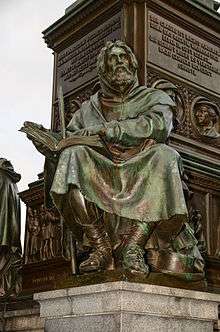History of Protestantism
| Protestantism |
|---|
 |
| The Reformation |
| Great Awakenings |
| History |
| Culture |
| Demographics |
|
|
| Major branches: |
|
|
|
Transdenominational movements: |
| Related movements: |
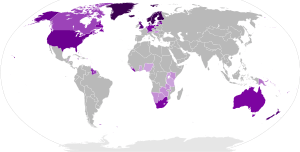

The Protestant Reformation began as an attempt to reform the Roman Catholic Church. Protestantism originated from the ideas of several theologians starting in the 12th century, although there could have been earlier cases of which there is no surviving evidence. However, these ideas were a subject to persecution by the Roman Catholic Church, and thus were kept isolated or effectively eradicated up to the 16th century. One of the early Protestant reformers was John Wycliffe, a theologian and an early proponent of reform in the 14th century. He influenced Jan Hus, a Czech priest from Prague, who in turn influenced German Martin Luther, who sparked the Protestant Reformation.
Martin Luther wrote Ninety-Five Theses on the sale of indulgences in 1517. At the same time, a movement began in Switzerland under the leadership of Huldrych Zwingli. The political separation of the Church of England from Rome under Henry VIII brought England alongside the broad Reformation movement.[1] The Scottish Reformation of 1560 decisively shaped the Church of Scotland.[2]
Following the excommunication of Luther, the Pope condemned the Reformation and its followers. The work and writings of John Calvin helped establish a loose consensus among various groups in Switzerland, Scotland, the Netherlands, Hungary, Germany and elsewhere.[3] In the course of this religious upheaval, the German Peasants' War of 1524–1525 swept through Bavaria, Thuringia and Swabia. The confessional division of the states of the Holy Roman Empire eventually erupted in the Thirty Years' War of 1618–1648, leaving the agglomeration severely weakened.[4]
The success of the Counter-Reformation on the Continent and the growth of a Puritan party dedicated to further Protestant reform polarized the Elizabethan Age, although it was not until the Civil War of the 1640s that England underwent religious strife comparable to that which its neighbours had suffered some generations before. Nonconforming Protestants along with the Protestant refugees from continental Europe were the primary founders of the United States of America.
The "Great Awakenings" were periods of rapid and dramatic religious revival in American religious history, from the 1730s to the mid-19th century. The result was a multitude of strong Protestant denominations, many quite new.
In the 20th century, Protestantism, especially in the United States, was becoming increasingly fragmented. Both liberal and conservative splinter groups asrose, as well as a general secularization of Western society. Notable developments in the 20th century of US Protestantism include the rise of Pentecostalism, Christian fundamentalism and Evangelicalism. While these movements spilled over to Europe to a limited degree, the development of Protestantism in Europe was more dominated by secularization, leading to an increasingly post-Christian Europe.
Origins
Protestants generally trace to the 16th century their separation from the Catholic Church. Mainstream Protestantism began with the Magisterial Reformation, so called because it received support from the magistrates (that is, the civil authorities). The Radical Reformation, had no state sponsorship. Older Protestant churches, such as the Unitas Fratrum (Unity of the Brethren), Moravian Brethren or the Bohemian Brethren trace their origin to the time of Jan Hus in the early 15th century. As the Hussite movement was led by a majority of Bohemian nobles and recognized for a time by the Basel Compacts, this is considered by some to be the first Magisterial Reformation in Europe. In Germany, a hundred years later, protests against Roman Catholic authorities erupted in many places at once during a time of threatened Islamic Ottoman invasion ¹ which distracted the German princes in particular. To some degree, these protests can be explained by the events of the previous two centuries in Europe and particularly in Bohemia. Earlier in the south of France, where the old influence of the Cathars led to the growing protests against the pope and his authorities, Guillaume Farel (b. 1489) preached reformation as early as 1522 in Dauphiné, where the French Wars of Religion later originated in 1562, also known as Huguenot wars. These also spread later to other parts of Europe.
Roots
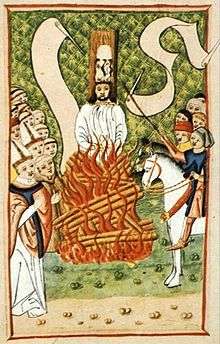
Unrest due to the Avignon Papacy and the Papal Schism in the Roman Catholic Church (1378–1416) sparked wars between princes, uprisings among peasants, and widespread concern over corruption in the Church. A new nationalism also challenged the relatively internationalist medieval world. The first of a series of disruptive and new perspectives came from John Wycliffe at Oxford University, then from Jan Hus at the University of Prague (Hus had been influenced by Wycliffe). The Catholic Church officially concluded debate over Hus' teachings at the Council of Constance (1414–1417). The conclave condemned Jan Hus, who was executed by burning in spite of a promise of safe-conduct. At the command of Pope Martin V, Wycliffe was exhumed and burned as a heretic twelve years after his burial.
The Council of Constance confirmed and strengthened the traditional medieval conception of Churches and Empires. It did not address the national or theological tensions which had been stirred up during the previous century. The council could not prevent schism and the Hussite Wars in Bohemia.[5]
Following the breakdown of monastic institutions and scholasticism in late medieval Europe, accentuated by the "Babylonian Captivity" of the Papacy, the Papal Schism, and the failure of the Conciliar movement, the sixteenth century saw a great cultural debate about religious reforms and later fundamental religious values (See German mysticism). Historians would generally assume that the failure to reform (too many vested interests, lack of coordination in the reforming coalition) would eventually lead to a greater upheaval or even revolution, since the system must eventually be adjusted or disintegrate, and the failure of the Conciliar movement helped lead to the Protestant Reformation in Europe. These frustrated reformist movements ranged from nominalism, devotio moderna (modern devotion), to humanism occurring in conjunction with economic, political and demographic forces that contributed to a growing disaffection with the wealth and power of the elite clergy, sensitizing the population to the financial and moral corruption of the secular Renaissance church.
The outcome of the Black Death encouraged a radical reorganization of the economy, and eventually of European society. In the emerging urban centers, however, the calamities of the fourteenth and early fifteenth century, and the resultant labor shortages, provided a strong impetus for economic diversification and technological innovations. Following the Black Death, the initial loss of life due to famine, plague, and pestilence contributed to an intensification of capital accumulation in the urban areas, and thus a stimulus to trade, industry, and burgeoning urban growth in fields as diverse as banking (the Fugger banking family in Augsburg and the Medici family of Florence being the most prominent); textiles, armaments, especially stimulated by the Hundred Years' War, and mining of iron ore due, in large part, to the booming armaments industry. Accumulation of surplus, competitive overproduction, and heightened competition to maximize economic advantage, contributed to civil war, aggressive militarism, and thus to centralization. As a direct result of the move toward centralization, leaders like Louis XI of France (1461–1483), the "spider king", sought to remove all constitutional restrictions on the exercise of their authority. In England, France, and Spain the move toward centralization begun in the thirteenth century was carried to a successful conclusion.
But as recovery and prosperity progressed, enabling the population to reach its former levels in the late 15th and 16th centuries, the combination of a newly-abundant labor supply and improved productivity, was a mixed blessing for many segments of Western European society. Despite tradition, landlords started to exclude peasants from "common lands". With trade stimulated, landowners increasingly moved away from the manorial economy. Woollen manufacturing greatly expanded in France, Germany, and the Netherlands and new textile industries began to develop.
The invention of movable type led to Protestant zeal for translating the Bible and getting it into the hands of the laity.
The "humanism" of the Renaissance period stimulated unprecedented academic ferment, and a concern for academic freedom. Ongoing, earnest theoretical debates occurred in the universities about the nature of the church, and the source and extent of the authority of the papacy, of councils, and of princes.
16th century
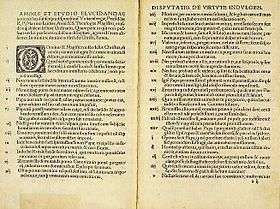
Protests against Rome began in earnest when Martin Luther, an Augustinian monk and professor at the university of Wittenberg, called in 1517 for a reopening of the debate on the sale of indulgences. The quick spread of discontent occurred to a large degree because of the printing press and the resulting swift movement of both ideas and documents, including the 95 Theses. Information was also widely disseminated in manuscript form, as well as by cheap prints and woodcuts amongst the poorer sections of society.
Parallel to events in Germany, a movement began in Switzerland under the leadership of Ulrich Zwingli. These two movements quickly agreed on most issues, as the recently introduced printing press spread ideas rapidly from place to place, but some unresolved differences kept them separate. Some followers of Zwingli believed that the Reformation was too conservative, and moved independently toward more radical positions, some of which survive among modern day Anabaptists. Other Protestant movements grew up along lines of mysticism or humanism (cf. Erasmus), sometimes breaking from Rome or from the Protestants, or forming outside of the churches.
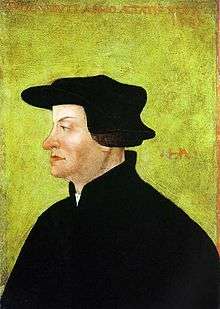
After this first stage of the Reformation, following the excommunication of Luther and condemnation of the Reformation by the Pope, the work and writings of John Calvin were influential in establishing a loose consensus among various groups in Switzerland, Scotland, Hungary, Germany and elsewhere.
The Reformation foundations engaged with Augustinianism. Both Luther and Calvin thought along lines linked with the theological teachings of Augustine of Hippo. The Augustinianism of the Reformers struggled against Pelagianism, a heresy that they perceived in the Catholic Church of their day. In the course of this religious upheaval, the German Peasants' War of 1524–1525 swept through the Bavarian, Thuringian and Swabian principalities, leaving scores of Catholics slaughtered at the hands of Protestant bands, including the Black Company of Florian Geier, a knight from Giebelstadt who joined the peasants in the general outrage against the Catholic hierarchy.
Even though Luther and Calvin had very similar theological teachings, the relationship between their followers turned quickly to conflict. Frenchman Michel de Montaigne told a story of a Lutheran pastor who once claimed that he would rather celebrate the mass of Rome than participate in a Calvinist service.
The political separation of the Church of England from Rome under Henry VIII, beginning in 1529 and completed in 1536, brought England alongside this broad Reformed movement. However, religious changes in the English national church proceeded more conservatively than elsewhere in Europe. Reformers in the Church of England alternated, for centuries, between sympathies for Catholic traditions and Protestantism, progressively forging a stable compromise between adherence to ancient tradition and Protestantism, which is now sometimes called the via media.[6]

Martin Luther, John Calvin, and Ulrich Zwingli are considered Magisterial Reformers because their reform movements were supported by ruling authorities or "magistrates". Frederick the Wise not only supported Luther, who was a professor at the university he founded, but also protected him by hiding Luther in Wartburg Castle in Eisenach. Zwingli and Calvin were supported by the city councils in Zurich and Geneva. Since the term "magister" also means "teacher", the Magisterial Reformation is also characterized by an emphasis on the authority of a teacher. This is made evident in the prominence of Luther, Calvin, and Zwingli as leaders of the reform movements in their respective areas of ministry. Because of their authority, they were often criticized by Radical Reformers as being too much like the Roman Popes. For example, Radical Reformer Andreas von Bodenstein Karlstadt referred to the Wittenberg theologians as the "new papists".[7]
Impact of humanism
The frustrated reformism of the humanists, ushered in by the Renaissance, contributed to a growing impatience among reformers. Erasmus and later figures like Martin Luther and Zwingli would emerge from this debate and eventually contribute to another major schism of Christendom. The crisis of theology beginning with William of Ockham in the fourteenth century was occurring in conjunction with the new burgher discontent. Since the breakdown of the philosophical foundations of scholasticism, the new nominalism did not bode well for an institutional church legitimized as an intermediary between man and God. New thinking favored the notion that no religious doctrine can be supported by philosophical arguments, eroding the old alliance between reason and faith of the medieval period laid out by Thomas Aquinas.

The major individualistic reform movements that revolted against medieval scholasticism and the institutions that underpinned it were humanism, devotionalism, (see for example, the Brothers of the Common Life and Jan Standonck) and the observantine tradition. In Germany, "the modern way" or devotionalism caught on in the universities, requiring a redefinition of God, who was no longer a rational governing principle but an arbitrary, unknowable will that cannot be limited. God was now a ruler, and religion would be more fervent and emotional. Thus, the ensuing revival of Augustinian theology, stating that man cannot be saved by his own efforts but only by the grace of God, would erode the legitimacy of the rigid institutions of the church meant to provide a channel for man to do good works and get into heaven. Humanism, however, was more of an educational reform movement with origins in the Renaissance's revival of classical learning and thought. A revolt against Aristotelian logic, it placed great emphasis on reforming individuals through eloquence as opposed to reason. The European Renaissance laid the foundation for the Northern humanists in its reinforcement of the traditional use of Latin as the great unifying language of European culture.
The polarization of the scholarly community in Germany over the Reuchlin (1455–1522) affair, attacked by the elite clergy for his study of Hebrew and Jewish texts, brought Luther fully in line with the humanist educational reforms who favored academic freedom. At the same time, the impact of the Renaissance would soon backfire against traditional Catholicism, ushering in an age of reform and a repudiation of much of medieval Latin tradition. Led by Erasmus, the humanists condemned various forms of corruption within the Church, forms of corruption that might not have been any more prevalent than during the medieval zenith of the church. Erasmus held that true religion was a matter of inward devotion rather than outward symbols of ceremony and ritual. Going back to ancient texts, scriptures, from this viewpoint the greatest culmination of the ancient tradition, are the guides to life. Favoring moral reforms and de-emphasizing didactic ritual, Erasmus laid the groundwork for Luther.
Humanism's intellectual anti-clericalism would profoundly influence Luther. The increasingly well-educated middle sectors of Northern Germany, namely the educated community and city dwellers would turn to Luther's rethinking of religion to conceptualize their discontent according to the cultural medium of the era. The great rise of the burghers, the desire to run their new businesses free of institutional barriers or outmoded cultural practices, contributed to the appeal of humanist individualism. To many, papal institutions were rigid, especially regarding their views on just price and usury. In the North, burghers and monarchs were united in their frustration for not paying any taxes to the nation, but collecting taxes from subjects and sending the revenues disproportionately to the Pope in Italy.
These trends heightened demands for significant reform and revitalization along with anticlericalism. New thinkers began noticing the divide between the priests and the flock. The clergy, for instance, were not always well-educated. Parish priests often did not know Latin and rural parishes often did not have great opportunities for theological education for many at the time. Due to its large landholdings and institutional rigidity, a rigidity to which the excessively large ranks of the clergy contributed, many bishops studied law, not theology, being relegated to the role of property managers trained in administration. While priests emphasized works of religiosity, the respectability of the church began diminishing, especially among well educated urbanites, and especially considering the recent strings of political humiliation, such as the apprehension of Pope Boniface VIII by Philip IV of France, the "Babylonian Captivity", the Great Schism, and the failure of Conciliar reformism. In a sense, the campaign by Pope Leo X to raise funds to rebuild St. Peter's Basilica was too much of an excess by the secular Renaissance church, prompting high-pressure indulgences that rendered the clergy establishments even more disliked in the cities.
Luther borrowed from the humanists the sense of individualism, that each man can be his own priest (an attitude likely to find popular support considering the rapid rise of an educated urban middle class in the North), and that the only true authority is the Bible, echoing the reformist zeal of the Conciliar movement and opening up the debate once again on limiting the authority of the Pope. While his ideas called for the sharp redefinition of the dividing lines between the laity and the clergy, his ideas were still, by this point, reformist in nature. Luther's contention that the human will was incapable of following good, however, resulted in his rift with Erasmus finally distinguishing Lutheran reformism from humanism.
Lutherans and the Holy Roman Empire
_-_Google_Art_Project.jpg)
Luther affirmed a theology of the Eucharist called Real Presence, a doctrine of the presence of Christ in the Eucharist which affirms the real presence yet upholding that the bread and wine are not "changed" into the body and blood; rather the divine elements adhere "in, with, and under" the earthly elements. He took this understanding of Christ's presence in the Eucharist to be more harmonious with the Church's teaching on the Incarnation. Just as Christ is the union of the fully human and the fully divine (cf. Council of Chalcedon) so to the Eucharist is a union of Bread and Body, Wine and Blood. According to the doctrine of real presence, the substances of the body and the blood of Christ and of the bread and the wine were held to coexist together in the consecrated Host during the communion service. While Luther seemed to maintain the perpetual consecration of the elements, other Lutherans argued that any consecrated bread or wine left over would revert to its former state the moment the service ended. Most Lutherans accept the latter.
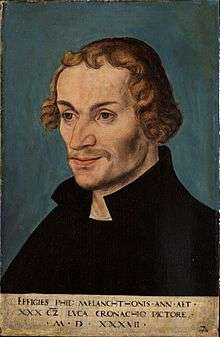
A Lutheran understanding of the Eucharist is distinct from the Reformed doctrine of the Eucharist in that Lutherans affirm a real, physical presence of Christ in the Eucharist (as opposed to either a "spiritual presence" or a "memorial") and Lutherans affirm that the presence of Christ does not depend on the faith of the recipient; the repentant receive Christ in the Eucharist worthily, the unrepentant who receive the Eucharist risk the wrath of Christ.
Luther, along with his colleague Philipp Melanchthon, emphasized this point in his plea for the Reformation at the Imperial Diet of 1529 amid charges of heresy. But the changes he proposed were of such a fundamental nature that by their own logic they would automatically overthrow the old order; neither the Emperor nor the Church could possibly accept them, as Luther well knew. As was only to be expected, the edict by the Diet of Worms (1521) prohibited all innovations. Meanwhile, in these efforts to retain the guise of a Catholic reformer as opposed to a heretical revolutionary, and to appeal to German princes with his religious condemnation of the peasant revolts backed up by the Doctrine of the Two Kingdoms, Luther's growing conservatism would provoke more radical reformers.
At a religious conference with the Zwinglians in 1529, Melanchthon joined with Luther in opposing a union with Zwingli. There would finally be a schism in the reform movement due to Luther's belief in real presence—the real (as opposed to symbolic) presence of Christ at the Eucharist. His original intention was not schism, but with the Diet of Augsburg (1530) and its rejection of the Lutheran Augsburg Confession, a separate Lutheran church finally emerged. In a sense, Luther would take theology further in its deviation from established Catholic dogma, forcing a rift between the humanist Erasmus and Luther. Similarly, Zwingli would further repudiate ritualism, and break with the increasingly conservative Luther.

Aside from the enclosing of the lower classes, the middle sectors of northern Germany, namely the educated community and city dwellers, would turn to religion to conceptualize their discontent according to the cultural medium of the era. The great rise of the burghers, the desire to run their new businesses free of institutional barriers or outmoded cultural practices contributed to the appeal of individualism. To many, papal institutions were rigid, especially regarding their views on just price and usury. In the North, burghers and monarchs were united in their frustration for not paying any taxes to the nation, but collecting taxes from subjects and sending the revenues disproportionately to Italy. In northern Europe, Luther appealed to the growing national consciousness of the German states because he denounced the Pope for involvement in politics as well as religion. Moreover, he backed the nobility, which was now justified to crush the Great Peasant Revolt of 1525 and to confiscate church property by Luther's Doctrine of the Two Kingdoms. This explains the attraction of some territorial princes to Lutheranism, especially its Doctrine of the Two Kingdoms. However, the Elector of Brandenburg, Joachim I, blamed Lutheranism for the revolt and so did others. In Brandenburg, it was only under his successor Joachim II that Lutheranism was established, and the old religion was not formally extinct in Brandenburg until the death of the last Catholic bishop there, Georg von Blumenthal, who was Bishop of Lebus and sovereign Prince-Bishop of Ratzeburg.
With the church subordinate to and the agent of civil authority and peasant rebellions condemned on strict religious terms, Lutheranism and German nationalist sentiment were ideally suited to coincide.
Though Charles V fought the Reformation, it is no coincidence either that the reign of his nationalistic predecessor Maximilian I saw the beginning of the movement. While the centralized states of western Europe had reached accords with the Vatican permitting them to draw on the rich property of the church for government expenditures, enabling them to form state churches that were greatly autonomous of Rome, similar moves on behalf of the Empire were unsuccessful so long as princes and prince bishops fought reforms to drop the pretension of the secular universal empire.
Protestant Reformation
In the early 16th century, the church was confronted with the challenge posed by Martin Luther to the traditional teaching on the church's doctrinal authority and to many of its practices as well. The seeming inability of Pope Leo X (1513–1521) and those popes who succeeded him to comprehend the significance of the threat that Luther posed - or, indeed, the alienation of many Christians by the corruption that had spread throughout the church - was a major factor in the rapid growth of the Protestant Reformation. By the time the need for a vigorous, reforming papal leadership was recognized, much of northern Europe had already converted to Protestantism.
Germany
.jpg)
Martin Luther was a German monk,[8] theologian, university professor, priest, father of Protestantism,[9][10][11][12] and church reformer whose ideas started the Protestant Reformation.[13]
Luther taught that salvation is a free gift of God and received only through true faith in Jesus as redeemer from sin. His theology challenged the authority of the papacy by adducing the Bible as the only infallible source of Christian doctrine[14] and countering "sacerdotalism" in the doctrine that all baptized Christians are a universal priesthood.[15]
Luther's refusal to retract his writings in confrontation with the Holy Roman Emperor Charles V at the Diet of Worms in 1521 resulted in his excommunication by Pope Leo X (actually on 3 January 1521, before the Diet convened) and declaration as an outlaw. His translation of the Bible into the language of the people made the Scriptures more accessible, causing a tremendous impact on the church and on German culture. It fostered the development of a standard version of the German language, added several principles to the art of translation,[16] and influenced the translation of the King James Bible.[17] His hymns inspired the development of congregational singing within Christianity.[18] His marriage to Katharina von Bora set a model for the practice of clerical marriage within Protestantism.[19]
In 1516-17, Johann Tetzel, a Dominican friar and papal commissioner for indulgences, was sent to Germany by the Roman Catholic Church to sell indulgences to raise money to rebuild St Peter's Basilica in Rome.[20] Roman Catholic theology stated that faith alone, whether fiduciary or dogmatic, cannot justify man;[21] and that only such faith as is active in charity and good works (fides caritate formata) can justify man.[22] These good works could be obtained by donating money to the church.
On 31 October 1517, Luther wrote to Albrecht, Archbishop of Mainz and Magdeburg, protesting the sale of indulgences. He enclosed in his letter a copy of his "Disputation of Martin Luther on the Power and Efficacy of Indulgences," which came to be known as The 95 Theses.
Luther objected to a saying attributed to Johann Tetzel that "As soon as the coin in the coffer rings, the soul from purgatory springs,"[23] insisting that, since forgiveness was God's alone to grant, those who claimed that indulgences absolved buyers from all punishments and granted them salvation were in error. Christians, he said, must not slacken in following Christ on account of such false assurances.

According to Walter Krämer, Götz Trenkler, Gerhard Ritter and Gerhard Prause,[24][25][26] the story of the posting on the door has settled as one of the pillars of history, but its foundations in truth are minimal. In the preface of the second pressing of Luther's compiled work, released posthumously, humanist and reformist Philipp Melanchthon writes 'reportedly, Luther, burning with passion and just devoutness, posted the Ninety-Five Theses at the Castle Church in Wittenberg, Germany at All Saints Eve, 31 October (Old calendar)". At the time of the writing of the preface Melanchton lived in Tübingen, far from Wittenberg. In the preface, Melanchton presents more facts that are not true: He writes that indulgence sales man Johann Tetzel publicly burned Luther's Ninety-Five Theses, that Luther held colleges on nature and physics, and that Luther had visited Rome in 1511. For a professor of the Wittenberg University to post thesis on doors is unparalleled in history. Even further, Luther is known as strongly law abiding, and to publish his thoughts and direction in such a way would be strongly against his character. Luther has never mentioned anything in this direction in his writings, and the only contemporary account of the publishing of the thesis is the account of Luther's servant Agricola, written in Latin. In this account, Agricola states that Luther presents 'certain thesis in the year of 1517 according to the customs of University of Wittenberg as part of a scientific discussion. The presentation of the thesis was done in a modest and respectful way, preventing to mock or insult anybody". There is no mention of nailing the thesis to a door, nor does any other source report this. In reality, Luther presented a hand-written copy, accompanied with honourable comments to the archbishop Albrecht of Mainz and Magdeburg, responsible for the practice of the indulgence sales, and to the bishop of Brandenburg, the superior of Luther.
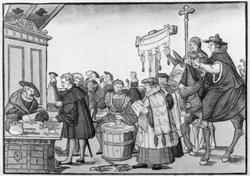
It wasn't until January 1518 that friends of Luther translated the 95 Theses from Latin into German, printed, and widely copied, making the controversy one of the first in history to be aided by the printing press.[27] Within two weeks, copies of the theses had spread throughout Germany; within two months throughout Europe. In contrast to the speed with which the theses were distributed, the response of the papacy was painstakingly slow. After three years of debate and negotiations involving Luther, government, and church officials, on 15 June 1520, the Pope warned Luther with the papal bull (edict) Exsurge Domine that he risked excommunication unless he recanted 41 sentences drawn from his writings, including the 95 Theses, within 60 days.
That autumn, Johann Eck proclaimed the bull in Meissen and other towns. Karl von Miltitz, a papal nuncio, attempted to broker a solution, but Luther, who had sent the Pope a copy of his conciliatory On the Freedom of a Christian (which the Pope refused to read) in October, publicly set fire to the bull and decretals at Wittenberg on 10 December 1520,[28] an act he defended in Why the Pope and his Recent Book are Burned and Assertions Concerning All Articles.
As a consequence, Luther was excommunicated by Leo X on 3 January 1521, in the bull Decet Romanum Pontificem.
Switzerland
Zwingli
Parallel to events in Germany, a movement began in Switzerland under the leadership of Huldrych Zwingli (died 1531). These two movements quickly agreed on most issues, as the recently introduced printing press spread ideas rapidly from place to place, but some unresolved differences kept them separate. Some followers of Zwingli believed that the Reformation was too conservative, and moved independently toward more radical positions, some of which survive among modern day Anabaptists. Other Protestant movements grew up along lines of mysticism or humanism (cf. Erasmus), sometimes breaking from Rome or from the Protestants, or forming outside of the churches.
John Calvin
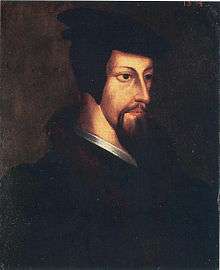
Following the excommunication of Luther and condemnation of the Reformation by the Pope, the work and writings of John Calvin were influential in establishing a loose consensus among various groups in Switzerland, Scotland, Hungary, Germany and elsewhere.
Geneva became the unofficial capital of the Protestant movement, led by the Frenchman, Jean Calvin, until his death in 1564 (when Calvin's ally, William Farel, assumed the spiritual leadership of the group).
The Reformation foundations engaged with Augustinianism. Both Luther and Calvin thought along lines linked with the theological teachings of Augustine of Hippo. The Augustinianism of the Reformers struggled against Pelagianism, a heresy that they perceived in the Catholic Church of their day. Ironically, even though both Luther and Calvin both had very similar theological teachings, the relationship between Lutherans and Calvinists evolved into one of conflict.
Scandinavia
All of Scandinavia ultimately adopted Lutheranism over the course of the sixteenth century, as the monarchs of Denmark (who also ruled Norway and Iceland) and Sweden (who also ruled Finland) converted to that faith.
In Sweden the Reformation was spearheaded by Gustav Vasa, elected king in 1523. Friction with the pope over the latter's interference in Swedish ecclesiastical affairs led to the discontinuance of any official connection between Sweden and the papacy from 1523.[29] Four years later, at the Diet of Västerås, the king succeeded in forcing the diet to accept his dominion over the national church. The king was given possession of all church property, church appointments required royal approval, the clergy were subject to the civil law, and the "pure Word of God" was to be preached in the churches and taught in the schools—effectively granting official sanction to Lutheran ideas.[29]
Under the reign of Frederick I (1523–33), Denmark remained officially Catholic. But though Frederick initially pledged to persecute Lutherans, he soon adopted a policy of protecting Lutheran preachers and reformers, of whom the most famous was Hans Tausen.[29] During his reign, Lutheranism made significant inroads among the Danish population. Frederick's son, Christian, was openly Lutheran, which prevented his election to the throne upon his father's death. However, following his victory in the civil war that followed, in 1537 he became Christian III and began a reformation of the official state church.
England
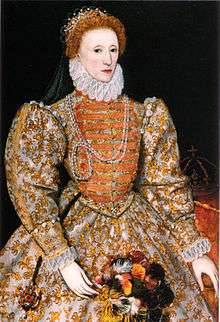
The separation of the Church of England from Rome under Henry VIII, beginning in 1529 and completed in 1536, brought England alongside this broad Reformed movement. However, religious changes in the English national church proceeded more conservatively than elsewhere in Europe; King Henry himself sought only to break the bond to Rome, but the bishops, in particular Thomas Cranmer, Archbishop of Canterbury, drove the newly freed church into Protestant reformation. Reformers in the Church of England alternated, for centuries, between sympathies for ancient traditions and more radical Protestantism, progressively forging a compromise between conservative practices and the ideas of the puritans. In the Victorian period this was reinterpreted by John Newman as a via media (middle way), which idea remains a current theme of Anglican discourse.
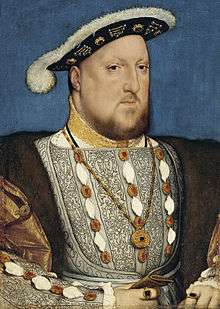
In England, the Reformation followed a different course from elsewhere in Europe. There had long been a strong strain of anti-clericalism, and England had already given rise to the Lollard movement of John Wycliffe, which played an important part in inspiring the Hussites in Bohemia. Lollardy was suppressed and became an underground movement so the extent of its influence in the 1520s is difficult to assess. The different character of the English Reformation came rather from the fact that it was driven initially by the political necessities of Henry VIII. Henry had once been a sincere Roman Catholic and had even authored a book strongly criticizing Luther, but he later found it expedient and profitable to break with the Papacy. His wife, Catherine of Aragon, bore him only a single child, Mary. As England had recently gone through a lengthy dynastic conflict (see Wars of the Roses), Henry feared that his lack of a male heir might jeopardize his descendants' claim to the throne. However, Pope Clement VII, concentrating more on Charles V's "sack of Rome", denied his request for an annulment. Had Clement granted the annulment and therefore admitted that his predecessor, Julius II, had erred, Clement would have given support to the Lutheran assertion that Popes replaced their own judgement for the will of God. King Henry decided to remove the Church of England from the authority of Rome. In 1534, the Act of Supremacy made Henry the Supreme Head of the Church of England. Between 1535 and 1540, under Thomas Cromwell, the policy known as the Dissolution of the Monasteries was put into effect. The veneration of some saints, certain pilgrimages and some pilgrim shrines were also attacked. Huge amounts of church land and property passed into the hands of the crown and ultimately into those of the nobility and gentry. The vested interest thus created made for a powerful force in support of the dissolutions.
There were some notable opponents to the Henrician Reformation, such as Thomas More and Bishop John Fisher, who were executed for their opposition. There was also a growing party of reformers who were imbued with the Zwinglian and Calvinistic doctrines now current on the Continent. When Henry died he was succeeded by his Protestant son Edward VI, who, through his empowered councillors (with the King being only nine years old at his succession and not yet sixteen at his death) the Duke of Somerset and the Duke of Northumberland, ordered the destruction of images in churches, and the closing of the chantries. Under Edward VI, and with Thomas Cranmer as Archbishop, the reform of the Church of England was established unequivocally in doctrinal terms. Yet, at a popular level, religion in England was still in a state of flux. Following a brief Roman Catholic restoration during the reign of Mary 1553–1558, a loose consensus developed during the reign of Elizabeth I, though this point is one of considerable debate among historians. Yet it is the so-called "Elizabethan Religious Settlement" to which the origins of Anglicanism are traditionally ascribed. The compromise was uneasy and was capable of veering between extreme Calvinism on the one hand and Catholicism on the other, but compared to the bloody and chaotic state of affairs in contemporary France, it was relatively successful until the Puritan Revolution or English Civil War in the seventeenth century.
Puritans

The success of the Counter-Reformation on the Continent and the growth of a Puritan party dedicated to further Protestant reform polarized the Elizabethan Age, although it was not until the 1640s that England underwent religious strife comparable to that which its neighbours had suffered some generations before.
The early Puritan movement (late 16th century-17th century) was Reformed or Calvinist and was a movement for reform in the Church of England. Its origins lay in the discontent with the Elizabethan Religious Settlement. The desire was for the Church of England to resemble more closely the Protestant churches of Europe, especially Geneva. The Puritans objected to ornaments and ritual in the churches as idolatrous (vestments, surplices, organs, genuflection), which they castigated as "popish pomp and rags". (See Vestments controversy.) They also objected to ecclesiastical courts. They refused to endorse completely all of the ritual directions and formulas of the Book of Common Prayer; the imposition of its liturgical order by legal force and inspection sharpened Puritanism into a definite opposition movement.
The later Puritan movement were often referred to as Dissenters and Nonconformists and eventually led to the formation of various Reformed denominations.
The most famous and well-known emigration to America was the migration of the Puritan separatists from the Anglican Church of England, who fled first to Holland, and then later to America, to establish the English colonies of New England, which later became the United States.
These Puritan separatists were also known as "the pilgrims". After establishing a colony at Plymouth (in what would become later Massachusetts) in 1620, the Puritan pilgrims received a charter from the King of England which legitimized their colony, allowing them to do trade and commerce with merchants in England, in accordance with the principles of mercantilism. This successful, though initially quite difficult, colony marked the beginning of the Protestant presence in America (the earlier French, Spanish and Portuguese settlements had been Catholic), and became a kind of oasis of spiritual and economic freedom, to which persecuted Protestants and other minorities from the British Isles and Europe (and later, from all over the world) fled to for peace, freedom and opportunity.
The original intent of the colonists was to establish spiritual Puritanism, which had been denied to them in England and the rest of Europe to engage in peaceful commerce with England and the Native American Indians and to Christianize the peoples of the Americas.
Scotland
The Reformation in Scotland's case culminated ecclesiastically in the re-establishment of the church along Reformed lines, and politically in the triumph of English influence over that of France. John Knox is regarded as the leader of the Scottish Reformation
The Reformation Parliament of 1560, which repudiated the pope's authority, forbade the celebration of the mass and approved a Protestant Confession of Faith, was made possible by a revolution against French hegemony under the regime of the regent Mary of Guise, who had governed Scotland in the name of her absent daughter Mary, Queen of Scots, (then also Queen of France).
The Scottish Reformation decisively shaped the Church of Scotland[2] and, through it, all other Presbyterian churches worldwide.
A spiritual revival also broke out among Catholics soon after Martin Luther's actions, and led to the Scottish Covenanters' movement, the precursor to Scottish Presbyterianism. This movement spread, and greatly influenced the formation of Puritanism among the Anglican Church in England. The Scottish Covenanters were persecuted by the Roman Catholic Church. This persecution by the Catholics drove some of the Protestant Covenanter leadership out of Scotland, and into France and later, Switzerland.
France
Protestantism also spread into France, where the Protestants were nicknamed "Huguenots", and this touched off decades of warfare in France, after initial support by Henry of Navarre was lost due to the "Night of the Placards" affair. Many French Huguenots however, still contributed to the Protestant movement, including many who emigrated to the English colonies.

Though he was not personally interested in religious reform, Francis I (1515–47) initially maintained an attitude of tolerance, arising from his interest in the humanist movement. This changed in 1534 with the Affair of the Placards. In this act, Protestants denounced the mass in placards that appeared across France, even reaching the royal apartments. The issue of religious faith having been thrown into the arena of politics, Francis was prompted to view the movement as a threat to the kingdom's stability. This led to the first major phase of anti-Protestant persecution in France, in which the Chambre Ardente ("Burning Chamber") was established within the Parlement of Paris to handle with the rise in prosecutions for heresy. Several thousand French Protestants fled the country during this time, most notably John Calvin, who settled in Geneva.
Calvin continued to take an interest in the religious affairs of his native land and, from his base in Geneva, beyond the reach of the French king, regularly trained pastors to lead congregations in France. Despite heavy persecution by Henry II, the Reformed Church of France, largely Calvinist in direction, made steady progress across large sections of the nation, in the urban bourgeoisie and parts of the aristocracy, appealing to people alienated by the obduracy and the complacency of the Catholic establishment.
French Protestantism, though its appeal increased under persecution, came to acquire a distinctly political character, made all the more obvious by the noble conversions of the 1550s. This had the effect of creating the preconditions for a series of destructive and intermittent conflicts, known as the Wars of Religion. The civil wars were helped along by the sudden death of Henry II in 1559, which saw the beginning of a prolonged period of weakness for the French crown. Atrocity and outrage became the defining characteristic of the time, illustrated at its most intense in the St. Bartholomew's Day massacre of August 1572, when the Catholic Church annihilated between 30,000 and 100,000 Huguenots across France.[30] The wars only concluded when Henry IV, himself a former Huguenot, issued the Edict of Nantes, promising official toleration of the Protestant minority, but under highly restricted conditions. Catholicism remained the official state religion, and the fortunes of French Protestants gradually declined over the next century, culminating in Louis XIV's Edict of Fontainebleau—which revoked the Edict of Nantes and made Catholicism the sole legal religion of France. In response to the Edict of Fontainebleau, Frederick William of Brandenburg declared the Edict of Potsdam, giving free passage to French Huguenot refugees, and tax-free status to them for 10 years.
Netherlands

The Reformation in the Netherlands, unlike in many other countries, was not initiated by the rulers of the Seventeen Provinces, but instead by multiple popular movements, which in turn were bolstered by the arrival of Protestant refugees from other parts of the continent. While the Anabaptist movement enjoyed popularity in the region in the early decades of the Reformation, Calvinism, in the form of the Dutch Reformed Church, became the dominant Protestant faith in the country from the 1560s onward.
Harsh persecution of Protestants by the Spanish government of Philip II contributed to a desire for independence in the provinces, which led to the Eighty Years' War and eventually, the separation of the largely Protestant Dutch Republic from the Catholic-dominated Southern Netherlands, the present-day Belgium.
Hungary
Much of the population of Kingdom of Hungary adopted Protestantism during the sixteenth century. After the 1526 Battle of Mohács the Hungarian people were disillusioned by the ability of the government to protect them and turned to the faith which would infuse them with the strength necessary to resist the Turkish invaders. They found this in the teaching of the Protestant Reformers such as Martin Luther. The spread of Protestantism in the country was aided by its large ethnic German minority, which could understand and translate the writings of Martin Luther. While Lutheranism gained a foothold among the German-speaking population, Calvinism became widely accepted among ethnic Hungarians.[31]
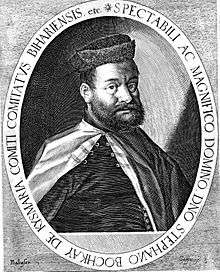
In the more independent northwest the rulers and priests, protected now by the Habsburg Monarchy which had taken the field to fight the Turks, defended the old Catholic faith. They dragged the Protestants to prison and the stake wherever they could. Such strong measures only fanned the flames of protest, however. Leaders of the Protestants included Matthias Biro Devai, Michael Sztarai, and Stephen Kis Szegedi.
Protestants likely formed a majority of Hungary's population at the close of the sixteenth century, but Counter-Reformation efforts in the seventeenth century reconverted a majority of the kingdom to Catholicism.[32] A significant Protestant minority remained, most of it adhering to the Calvinist faith.
In 1558 the Transylvanian Diet of Turda declared free practice of both the Catholic and Lutheran religions, but prohibited Calvinism. Ten years later, in 1568, the Diet extended this freedom, declaring that "It is not allowed to anybody to intimidate anybody with captivity or expelling for his religion". Four religions were declared as accepted (recepta) religions, while Orthodox Christianity was "tolerated" (though the building of stone Orthodox churches was forbidden). Hungary entered the Thirty Years' War, Royal (Habsburg) Hungary joined the catholic side, until Transylvania joined the Protestant side.
There were a series of other successful and unsuccessful anti-Habsburg /i.e. anti-Austrian/ (requiring equal rights and freedom for all Christian religions) uprisings between 1604 and 1711, the uprisings were usually organized from Transylvania. The constrained Habsburg Counter-Reformation efforts in the seventeenth century reconverted the majority of the kingdom to Catholicism.
Nineteenth century
Historian Kenneth Scott Latourette argues that the outlook for Protestantism at the start of the 19th century was discouraging. It was a regional religion based in northwestern Europe, with an outpost in the sparsely settled United States. It was closely allied with government, as in Scandinavia, the Netherlands, Prussia, and especially Great Britain. The alliance came at the expense of independence, as the government made the basic policy decisions, down to such details as the salaries of ministers and location of new churches. The dominant intellectual currents of the Enlightenment promoted rationalism, and most Protestant leaders preached a sort of deism. Intellectually, the new methods of historical and anthropological study undermine automatic acceptance of biblical stories, as did the sciences of geology and biology. Industrialization was a strongly negative factor, as workers who moved to the city seldom joined churches. The gap between the church and the unchurched grew rapidly, and secular forces, based both in socialism and liberalism undermine the prestige of religion. Despite the negative forces, Protestantism demonstrated a striking vitality by 1900. Shrugging off Enlightenment rationalism, Protestants embraced romanticism, with the stress on the personal and the invisible. Entirely fresh ideas as expressed by Friedrich Schleiermacher, Soren Kierkegaard, Albrecht Ritschl and Adolf von Harnack restored the intellectual power of theology. There was more attention to historic creeds such as the Augsburg, the Heidelberg, and the Westminster confessions. The stirrings of pietism on the Continent, and evangelicalism in Britain expanded enormously, leading the devout away from an emphasis on formality and ritual and toward an inner sensibility toward personal relationship to Christ. From the religious point of view of the typical Protestant, major changes were underway in terms of a much more personalized religiosity that focused on the individual more than the church or the ceremony. The rationalism of the late 19th century faded away, and there was a new emphasis on the psychology and feeling of the individual, especially in terms of contemplating sinfuness, redemption, and the mysteries and the revelations of Christianity. Pietistic revivals were common among Protestants. Social activities, in education and in opposition to social vices such as slavery, alcoholism and poverty provided new opportunities for social service. Above all, worldwide missionary activity became a highly prized goal, proving quite successful in close cooperation with the imperialism of the British, German, and Dutch empires.[33]
Britain
In England, Anglicans emphasized the historically Catholic components of their heritage, as the High Church element reintroduced vestments and incense into their rituals, against the opposition of Low Church evangelicals.[34] As the Oxford Movement began to advocate restoring traditional Catholic faith and practice to the Church of England (see Anglo-Catholicism), there was felt to be a need for a restoration of the monastic life. Anglican priest John Henry Newman established a community of men at Littlemore near Oxford in the 1840s. From then forward, there have been many communities of monks, friars, sisters, and nuns established within the Anglican Communion. In 1848, Mother Priscilla Lydia Sellon founded the Anglican Sisters of Charity and became the first woman to take religious vows within the Anglican Communion since the English Reformation. From the 1840s and throughout the following hundred years, religious orders for both men and women proliferated in Britain, America and elsewhere.[35]
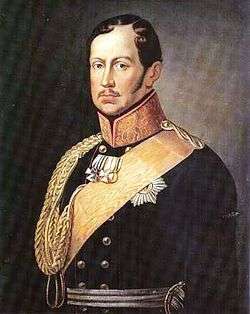
Germany
Two main developments reshaped religion in Germany. Across the land, there was a movement to unite the larger Lutheran and the smaller Reformed Protestant churches. The churches themselves brought this about in Baden, Nassau, and Bavaria. However, in Prussia King Frederick William III was determined to handle unification entirely on his own terms, without consultation. His goal was to unify the Protestant churches, and to impose a single standardized liturgy, organization and even architecture. The long-term goal was to have fully centralized royal control of all the Protestant churches. In a series of proclamations over several decades the Church of the Prussian Union was formed, bringing together the more numerous Lutherans, and the less numerous Reformed Protestants. The government of Prussia now had full control over church affairs, with the king himself recognized as the leading bishop. Opposition to unification came from the "Old Lutherans" in Silesia who clung tightly to the theological and liturgical forms they had followed since the days of Luther. The government attempted to crack down on them, so they went underground. Tens of thousands migrated, to South Australia, and especially to the United States, where they formed the Missouri Synod, which is still in operation as a conservative denomination. Finally in 1845 a new king Frederick William IV offered a general amnesty and allowed the Old Lutherans to form a separate church association with only nominal government control.[36][37][38]
The Great Awakenings in America
| Great Awakening |
|---|
The "Great Awakenings" were periods of rapid and dramatic religious revival in American religious history, beginning in the 1730s.
First Great Awakening
The "First Great Awakening" (or sometimes "The Great Awakening") was a wave of religious enthusiasm among Protestants that swept the American colonies in the 1730s and 1740s, leaving a permanent impact on American religion. It emphasized the traditional Reformed virtues of Godly preaching, rudimentary liturgy, and a deep sense of personal guilt and redemption by Christ Jesus. It resulted from powerful preaching that deeply affected listeners (already church members) with a deep sense of personal guilt and salvation by Christ. Pulling away from ritual and ceremony, the Great Awakening made religion intensely personal to the average person by creating a deep sense of spiritual guilt and redemption. Historian Sydney E. Ahlstrom saw it as part of a "great international Protestant upheaval" that also created Pietism in Germany, the Evangelical Revival, and Methodism in England.[39] It had a major impact in reshaping the Congregational, Presbyterian, Dutch Reformed, and German Reformed denominations, and strengthened the small Baptist and Methodist denominations. It brought Christianity to the slaves and was an apocalyptic event in New England that challenged established authority. It incited rancor and division between the old traditionalists who insisted on ritual and doctrine and the new revivalists. It had little impact on Anglicans and Quakers.
Unlike the Second Great Awakening that began about 1800 and which reached out to the unchurched, the First Great Awakening focused on people who were already church members. It changed their rituals, their piety, and their self-awareness. The new style of sermons and the way people practiced their faith breathed new life into religion in America. People became passionately and emotionally involved in their religion, rather than passively listening to intellectual discourse in a detached manner. Ministers who used this new style of preaching were generally called "new lights", while the preachers of old were called "old lights". People began to study the Bible at home, which effectively decentralized the means of informing the public on religious manners and was akin to the individualistic trends present in Europe during the Protestant Reformation.
Second Great Awakening

The "Second Great Awakening" (1790-1840s) was the second great religious revival in United States history and, unlike the First Great Awakening of the 18th century, focused on the unchurched and sought to instil in them a deep sense of personal salvation as experienced in revival meetings. It also sparked the beginnings of groups such as the Mormons[40] and the Holiness movement. Leaders included Charles Grandison Finney, Lyman Beecher, Barton W. Stone, Peter Cartwright and James Finley.
In New England, the renewed interest in religion inspired a wave of social activism. In western New York, the spirit of revival encouraged the emergence of the Restoration Movement, the Latter Day Saint movement, Adventism and the Holiness movement. In the west especially—at Cane Ridge, Kentucky and in Tennessee—the revival strengthened the Methodists and the Baptists and introduced into America a new form of religious expression—the Scottish camp meeting.
The Second Great Awakening made its way across the frontier territories, fed by intense longing for a prominent place for God in the life of the new nation, a new liberal attitude toward fresh interpretations of the Bible, and a contagious experience of zeal for authentic spirituality. As these revivals spread, they gathered converts to Protestant sects of the time. However, the revivals eventually moved freely across denominational lines, with practically identical results, and went farther than ever toward breaking down the allegiances which kept adherents to these denominations loyal to their own. Consequently, the revivals were accompanied by a growing dissatisfaction with Evangelical churches and especially with the doctrine of Calvinism, which was nominally accepted or at least tolerated in most Evangelical churches at the time. Various unaffiliated movements arose that were often restorationist in outlook, considering contemporary Christianity of the time to be a deviation from the true, original Christianity. These groups attempted to transcend Protestant denominationalism and orthodox Christian creeds to restore Christianity to its original form.
Third Great Awakening

The "Third Great Awakening" was a period of religious activism in American history from the late 1850s to the 1900s. It affected pietistic Protestant denominations and had a strong sense of social activism. It gathered strength from the postmillennial theology that the Second Coming of Christ would come after mankind had reformed the entire earth. The Social Gospel Movement gained its force from the Awakening, as did the worldwide missionary movement. New groupings emerged, such as the Holiness movement and Nazarene movements, and Christian Science.[41] Significant names include Dwight L. Moody, Ira D. Sankey, William Booth and Catherine Booth (founders of the Salvation Army), Charles Spurgeon and James Caughey. Hudson Taylor began the China Inland Mission and Thomas John Barnardo founded his famous orphanages. The Keswick Convention movement began out of the British Holiness movement, encouraging a lifestyle of holiness, unity and prayer.
Mary Baker Eddy introduced Christian Science, which gained a national following. In 1880, the Salvation Army denomination arrived in America. Although its theology was based on ideals expressed during the Second Great Awakening, its focus on poverty was of the Third. The Society for Ethical Culture was established in New York City in 1876 by Felix Adler attracted a Reform Jewish clientele. Charles Taze Russell founded a Bible Student movement now known as The Jehovah's Witnesses
With Jane Addams's Hull House in Chicago as its center, the settlement house movement and the vocation of social work were deeply influenced by the Tolstoyan reworking of Christian idealism.[42] The final group to emerge from this awakening in North America was Pentecostalism, which had its roots in the Methodist, Wesleyan, and Holiness movements, and began in 1906 on Azusa Street, in Los Angeles. Pentecostalism would later lead to the Charismatic movement.
20th century
Protestant Christianity in the 20th century was characterized by accelerating fragmentation. The century saw the rise of both liberal and conservative splinter groups, as well as a general secularization of Western society. The Roman Catholic Church instituted many reforms in order to modernize. Missionaries also made inroads in the Far East, establishing further followings in China, Taiwan, Korea, and Japan. At the same time, state-promoted atheism in Communist Eastern Europe and the Soviet Union brought many Eastern Orthodox Christians to Western Europe and the United States, leading to greatly increased contact between Western and Eastern Christianity. Nevertheless, church attendance declined more in Western Europe than it did in the East. Christian ecumenism grew in importance, beginning at the Edinburgh Missionary Conference in 1910, and accelerated after the Second Vatican Council (1962–1965) of the Catholic Church, The Liturgical Movement became significant in both Catholic and Protestant Christianity, especially in Anglicanism.
Another movement which has grown up over the 20th century has been Christian anarchism which rejects the church, state or any power other than God. They usually also believe in absolute nonviolence. Leo Tolstoy's book The Kingdom of God is Within You published in 1894, is believed to be the catalyst for this movement. Because of its extremist political views, however, its appeal has been largely limited to the highly educated, especially those with erstwhile humanist sentiments; the thoroughgoing aversion to institutionalism on Christian anarchists' part has also hindered acceptance of this philosophy on a large scale.
The 1950s saw a boom in the Evangelical church in America. The post–World War II prosperity experienced in the U.S. also had its effects on the church. Although simplistically referred to as "morphological fundamentalism", the phrase nonetheless does accurately describe the physical developments experienced. Church buildings were erected in large numbers, and the Evangelical church's activities grew along with this expansive physical growth.
Pentecostal movement
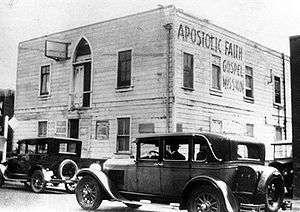
Another noteworthy development in 20th-century Christianity was the rise of the modern Pentecostal movement. Although its roots predate the year 1900, its actual birth is commonly attributed to the 20th century. Sprung from Methodist and Wesleyan roots, it arose out of meetings at an urban mission on Azusa Street in Los Angeles. From there it spread around the world, carried by those who experienced what they believed to be miraculous moves of God there. These Pentecost-like manifestations have steadily been in evidence throughout the history of Christianity—such as seen in the two Great Awakenings that started in the United States. However, Azusa Street is widely accepted as the fount of the modern Pentecostal movement. Pentecostalism, which in turn birthed the Charismatic movement within already established denominations, continues to be an important force in western Christianity.
Modernism, fundamentalism, and neo-orthodoxy
As the more radical implications of the scientific and cultural influences of the Enlightenment began to be felt in the Protestant churches, especially in the 19th century, Liberal Christianity, exemplified especially by numerous theologians in Germany in the 19th century, sought to bring the churches alongside of the broad revolution that Modernism represented. In doing so, new critical approaches to the Bible were developed, new attitudes became evident about the role of religion in society, and a new openness to questioning the nearly universally accepted definitions of Christian orthodoxy began to become obvious.

In reaction to these developments, Christian fundamentalism was a movement to reject the radical influences of philosophical humanism, as this was affecting the Christian religion. Especially targeting critical approaches to the interpretation of the Bible, and trying to blockade the inroads made into their churches by atheistic scientific assumptions, the fundamentalists began to appear in various denominations as numerous independent movements of resistance to the drift away from historic Christianity. Over time, the Fundamentalist Evangelical movement has divided into two main wings, with the label Fundamentalist following one branch, while Evangelical has become the preferred banner of the more moderate movement. Although both movements primarily originated in the English speaking world, the majority of Evangelicals now live elsewhere in the world.
A third, but less popular, option than either liberalism or fundamentalism was the neo-orthodox movement, which generally affirmed a higher view of Scripture than liberalism but did not tie the main doctrines of the Christian faith to precise theories of Biblical inspiration. If anything, thinkers in this camp denounced such quibbling between liberals and conservatives as a dangerous distraction from the duties of Christian discipleship. This branch of thought arose in the early 20th century in the context of the rise of the Third Reich in Germany and the accompanying political and ecclesiastical destabilization of Europe in the years before and during World War II. Neo-orthodoxy's highly contextual, dialectical modes of argument and reasoning often rendered its main premises incomprehensible to American thinkers and clergy, and it was frequently either dismissed out of hand as unrealistic or cast into the reigning left- or right-wing molds of theologizing. Karl Barth, a Swiss Reformed pastor and professor, brought this movement into being by drawing upon earlier criticisms of established (largely modernist) Protestant thought made by the likes of Søren Kierkegaard and Franz Overbeck; Dietrich Bonhoeffer, murdered by the Nazis for allegedly taking part in an attempt to overthrow the Hitler regime, adhered to this school of thought; his classic The Cost of Discipleship is likely the best-known and accessible statement of the neo-orthodox position.
Evangelicalism

In the U.S. and elsewhere in the world, there has been a marked rise in the evangelical wing of Protestant denominations, especially those that are more exclusively evangelical, and a corresponding decline in the mainstream liberal churches. In the post–World War I era, Liberalism was the faster-growing sector of the American church. Liberal wings of denominations were on the rise, and a considerable number of seminaries held and taught from a liberal perspective as well. In the post–World war II era, the trend began to swing back towards the conservative camp in America's seminaries and church structures. Those entering seminaries and other postgraduate theologically related programs have shown more conservative leanings than their average predecessors.
The neo-Evangelical push of the 1940s and 1950s produced a movement that continues to have wide influence. In the southern U.S., the more moderate neo-Evangelicals, represented by leaders such as Billy Graham, have experienced a notable surge displacing the caricature of the pulpit pounding country preachers of fundamentalism. The stereotypes have gradually shifted. Some, such as Jerry Falwell, have managed to maintain credibility in the eyes of many fundamentalists, as well as to gain stature as a more moderate Evangelical.

Evangelicalism is not a single, monolithic entity. The Evangelical churches and their adherents cannot be easily stereotyped. Most are not fundamentalist, in the narrow sense that this term has come to represent; though many still refer to themselves as such. There have always been diverse views on issues, such as openness to cooperation with non-Evangelicals, the applicability of the Bible to political choices and social or scientific issues, and even the limited inerrancy of the Bible.
However, the movement has managed in an informal way, to reserve the name Evangelical for those who adhere to an historic Christian faith, a paleo-orthodoxy, as some have put it. Those who call themselves "moderate evangelicals"(although considered conservative in relation to society as a whole) still hold fast to the fundamentals of the historic Christian faith. Even "Liberal" Evangelicals label themselves as such not so much in terms of their theology, but rather to advertise that they are progressive in their civic, social, or scientific perspective.
There is some debate as to whether Pentecostals are considered to be Evangelical. Their roots in Pietism and the Holiness movement are undisputedly Evangelical, but their doctrinal distinctives differ from the more traditional Evangelicals, who are less likely to have an expectation of private revelations from God, and differ from the Pentecostal perspective on miracles, angels, and demons. Typically, those who include the Pentecostals in the Evangelical camp are labeled neo-evangelical by those who do not. The National Association of Evangelicals and the Evangelical Alliance have numerous Trinitarian Pentecostal denominations among their membership.[45] Another relatively late entrant to wide acceptance within the Evangelical fold is the Seventh-day Adventist Church.
Evangelicals are as diverse as the names that appear—Billy Graham, Chuck Colson, J. Vernon McGee, John MacArthur, J.I. Packer, John R.W. Stott, Pat Robertson, Jimmy Carter, etc.—or even Evangelical institutions such as Dallas Theological Seminary (dispensationalist), Gordon-Conwell Theological Seminary (Boston), Trinity Evangelical Divinity School (Chicago), The Master's Seminary (California), Wheaton College (Illinois), the Christian Coalition, The Christian Embassy (Jerusalem), etc. Although there exists a diversity in the Evangelical community worldwide, the ties that bind all Evangelicals are still apparent. These include but are not limited to a high view of Scripture, belief in the Deity of Christ, the Trinity, salvation by grace alone through faith alone, and the bodily resurrection of Christ.
Spread of secularism

- Europe
In Europe there has been a general move away from religious observance and belief in Christian teachings and a move towards secularism. The "secularization of society", attributed to the time of the Enlightenment and its following years, is largely responsible for the spread of secularism. For example, the Gallup International Millennium Survey showed that only about one sixth of Europeans attend regular religious services, less than half gave God "high importance", and only about 40% believe in a "personal God". Nevertheless, the large majority considered that they "belong" to a religious denomination.
- The Americas and Australia
In North America, South America and Australia, the other three continents where Christianity is the dominant professed religion, religious observance is much higher than in Europe. At the same time, these regions are often seen by other nations as being uptight and "Victorian", in their social mores. In general, the United States leans toward the conservative in comparison to other western nations in its general culture, in part due to the Christian element found primarily in its Midwestern and southern states.
South America, historically Catholic, has experienced a large Evangelical and Pentecostal infusion in the 20th century due to the influx of Christian missionaries from abroad. For example: Brazil, South America's largest country, is the largest Catholic country in the world, and at the same time is the largest Evangelical country in the world (based on population). Some of the largest Christian congregations in the world are found in Brazil.
See also
- Christianity in the 19th century
- History of Christianity of the Late Modern era
- Christianity in the 18th century
- Christianity in the 20th century
- History of the Roman Catholic Church
- Revival (religious)
- Timeline of Christianity
Notes
- ↑ The Reformation of the Church of England: Its History, Principles, and Results. A.D. 1514-1547, p. 400
- 1 2 Article 1, of the Articles Declaratory of the Constitution of the Church of Scotland 1921 states 'The Church of Scotland adheres to the Scottish Reformation'.
- ↑ Ecclesia Reformata: Studies on the Reformation, Tom 2, p. 67
- ↑ The Thirty Years War: Europe's Tragedy
- ↑ Hussites
- ↑ The Sacking of Rome & The English Reformation Archived 15 January 2009 at the Wayback Machine.
- ↑ Gstohl, Mark (2004). "The Magisterial Reformation". Theological Perspectives of the Reformation. Retrieved 2007-06-27.
- ↑ Plass, Ewald M. "Monasticism," in What Luther Says: An Anthology. St. Louis: Concordia Publishing House, 1959, 2:964.
- ↑ Challenges to Authority: The Renaissance in Europe: A Cultural Enquiry, Volume 3, by Peter Elmer, page 25
- ↑ "Martin Luther: Biography." AllSands.com. 26 July 2008 http://www.allsands.com/potluck3/martinlutherbi_ugr_gn.htm>.
- ↑ "What ELCA Lutherans Believe." Evangelical Lutheran Church in America. 26 July 2008 .
- ↑ Saraswati, Prakashanand. The True History and the Religion of India : A Concise Encyclopedia of Authentic Hinduism. New York: Motilal Banarsidass (Pvt. Ltd), 2001. "His 'protest for reformation' coined the term Protestant, so he was called the father of Protestantism."
- ↑ Hillerbrand, Hans J. "Martin Luther: Significance," Encyclopaedia Britannica, 2007.
- ↑ Ewald M. Plass, What Luther Says, 3 vols., (St. Louis: CPH, 1959), 88, no. 269; M. Reu, Luther and the Scriptures, Columbus, Ohio: Wartburg Press, 1944), 23.
- ↑ Luther, Martin. Concerning the Ministry (1523), tr. Conrad Bergendoff, in Bergendoff, Conrad (ed.) Luther's Works. Philadelphia: Fortress Press, 1958, 40:18 ff.
- ↑ Fahlbusch, Erwin and Bromiley, Geoffrey William. The Encyclopedia of Christianity. Grand Rapids, MI: Leiden, Netherlands: Wm. B. Eerdmans; Brill, 1999–2003, 1:244.
- ↑ Tyndale's New Testament, trans. from the Greek by William Tyndale in 1534 in a modern-spelling edition and with an introduction by David Daniell. New Haven, CT: Yale University Press, 1989, ix–x.
- ↑ Bainton, Roland. Here I Stand: a Life of Martin Luther. New York: Penguin, 1995, 269.
- ↑ Bainton, Roland. Here I Stand: a Life of Martin Luther. New York: Penguin, 1995, 223.
- ↑ "Johann Tetzel," Encyclopædia Britannica, 2007: "Tetzel's experiences as a preacher of indulgences, especially between 1503 and 1510, led to his appointment as general commissioner by Albrecht, archbishop of Mainz, who, deeply in debt to pay for a large accumulation of benefices, had to contribute a considerable sum toward the rebuilding of St. Peter's Basilica in Rome. Albrecht obtained permission from Pope Leo X to conduct the sale of a special plenary indulgence (i.e., remission of the temporal punishment of sin), half of the proceeds of which Albrecht was to claim to pay the fees of his benefices. In effect, Tetzel became a salesman whose product was to cause a scandal in Germany that evolved into the greatest crisis (the Reformation) in the history of the Western church."
- ↑ (Trent, l. c., can. xii: "Si quis dixerit, fidem justificantem nihil aliud esse quam fiduciam divinae misericordiae, peccata remittentis propter Christum, vel eam fiduciam solam esse, qua justificamur, a.s.")
- ↑ (cf. Trent, Sess. VI, cap. iv, xiv)
- ↑ Bainton, Roland. Here I Stand: a Life of Martin Luther. New York: Penguin, 1995, 60; Brecht, Martin. Martin Luther. tr. James L. Schaaf, Philadelphia: Fortress Press, 1985–93, 1:182; Kittelson, James. Luther The Reformer. Minneapolis: Augsburg Fortress Publishing House, 1986),104.
- ↑ Krämer, Walter and Trenkler, Götz. "Luther," in Lexicon van Hardnekkige Misverstanden. Uitgeverij Bert Bakker, 1997, 214:216.
- ↑ Ritter, Gerhard. "Luther, Frankfurt 1985.
- ↑ Gerhard Prause "Luthers Thesanschlag ist eine Legende,"in Niemand hat Kolumbus ausgelacht. Düsseldorf, 1986.
- ↑ Brecht, Martin. Martin Luther. tr. James L. Schaaf, Philadelphia: Fortress Press, 1985–93, 1:204–205.
- ↑ Brecht, Martin. (tr. Wolfgang Katenz) "Luther, Martin," in Hillerbrand, Hans J. (ed.) Oxford Encyclopedia of the Reformation. New York: Oxford University Press, 1996, 2:463.
- 1 2 3 Chapter 12 The Reformation In Germany And Scandinavia, Renaissance and Reformation by William Gilbert.
- ↑ Paris and the St. Bartholomew's Day Massacre: August 24, 1572
- ↑ Revesz, Imre, History of the Hungarian Reformed Church, Knight, George A.F. ed., Hungarian Reformed Federation of America (Washington, D.C.: 1956).
- ↑ The Forgotten Reformations in Eastern Europe - Resources
- ↑ Kenneth Scott Latourette, Christianity in a Revolutionary Age, II: The Nineteenth Century in Europe: The Protestant and Eastern Churches (1959) pp 428-31
- ↑ Owen Chadwick, Victorian Church (2 vol. 1979)
- ↑ Thomas Jay Williams, Priscilla Lydia Sellon: the restorer after three centuries of the religious life in the English church (SPCK, 1965).
- ↑ Christopher Clark, Iron Kingdom (2006) pp 412-19
- ↑ Christopher Clark, "Confessional policy and the limits of state action: Frederick William III and the Prussian Church Union 1817–40." Historical Journal 39.04 (1996) pp: 985-1004. in JSTOR
- ↑ Hajo Holborn, A History of Modern Germany 1648-1840 (1964) pp 485-91
- ↑ Sydney E. Ahlstrom, A Religious History of the American People. (New Haven and London: Yale University Press, 1972) p. 263
- ↑ Matzko, John (2007). "The Encounter of the Young Joseph Smith with Presbyterianism". Dialogue: A Journal of Mormon Thought. 40 (3): 68–84. Presbyterian historian Matzko notes that "Oliver Cowdery claimed that Smith had been 'awakened' during a sermon by the Methodist minister George Lane."
- ↑ Robert William Fogel, The Fourth Great Awakening & the Future of Egalitarianism University of Chicago Press, 20000 ISBN 0-226-25662-6. excerpt
- ↑ Jane Addams, Twenty Years at Hull House; Edmund Wilson, The American Earthquake.
- ↑ McGrath, Alister E (January 14, 2011), Christian Theology: An Introduction, John Wiley & Sons, pp. 76–, ISBN 978-1-4443-9770-3
- ↑ Brown, Stuart; Collinson, Diane; Wilkinson, Robert (September 10, 2012), Biographical Dictionary of Twentieth-Century Philosophers, Taylor & Francis, pp. 52–, ISBN 978-0-415-06043-1
- ↑ Church Search
Further reading
- Ahlstrom, Sydney E. A Religious History of the American People (1972, 2nd ed. 2004); widely cited standard scholarly history excerpt and text search
- Chadwick, Owen. A History of Christianity (1995)
- Gilley, Sheridan, and Brian Stanley, eds. The Cambridge History of Christianity: Volume 8, World Christianities c.1815-c.1914 (2006) excerpt
- González, Justo L. (1984). The Story of Christianity: Vol. 1: The Early Church to the Reformation. San Francisco: Harper. ISBN 0-06-063315-8.
- González, Justo L. (1985). The Story of Christianity, Vol. 2: The Reformation to the Present Day. San Francisco: Harper. ISBN 0-06-063316-6.
- Hastings, Adrian (1999). A World History of Christianity. Wm. B. Eerdmans Publishing. ISBN 0-8028-4875-3.
- Latourette, Kenneth Scott (1975). A History of Christianity, Volume 1: Beginnings to 1500 (Revised). San Francisco: Harper. ISBN 0-06-064952-6.
- Latourette, Kenneth Scott (1975). A History of Christianity, Volume 2: 1500 to 1975. San Francisco: Harper. ISBN 0-06-064953-4.
- Latourette, Kenneth Scott. Christianity in a Revolutionary Age, I: The Nineteenth Century in Europe: Background and the Roman Catholic Phase; Christianity in a Revolutionary Age, II: The Nineteenth Century in Europe: The Protestant and Eastern Churches; Christianity in a Revolutionary Age, III: The Nineteenth Century Outside Europe: The Americas, the Pacific, Asia and Africa (1959–69), detailed survey by leading scholar
- Lippy, Charles H., ed. Encyclopedia of the American Religious Experience (3 vol. 1988)
- Lynch, John. New Worlds: A Religious History of Latin America (2012)
- MacCulloch, Diarmaid. Christianity: The First Three Thousand Years (2011)
- MacCulloch, Diarmaid. The Reformation (2005)
- McLeod, Hugh. Religion and the People of Western Europe 1789–1989 (Oxford UP, 1997)
- McLeod, Hugh and Werner Ustorf, eds. The Decline of Christendom in Western Europe, 1750-2000 (Cambridge UP, 2004) online
- Marshall, Peter. The Reformation: A Very Short Introduction (2009)
- Noll, Mark A. A History of Christianity in the United States and Canada (1992)
- Rosman, Doreen. The Evolution of the English Churches, 1500-2000 (2003) 400pp
External links
|
The following links give an overview of the history of Christianity:
|
The following link provides quantitative data related to Christianity and other major religions, including rates of adherence at different points in time:
|
| Wikimedia Commons has media related to History of Protestantism. |

